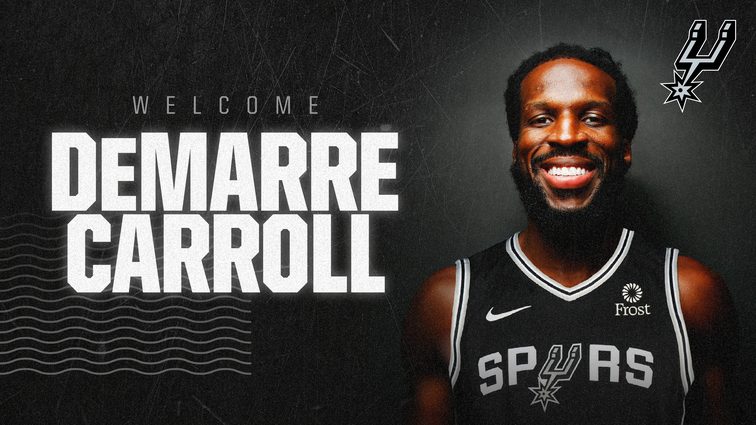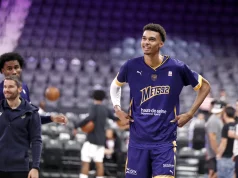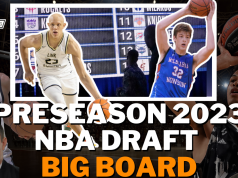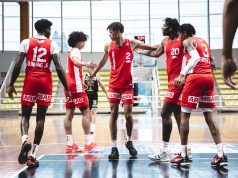On June 30th, shortly after the start of free agency, the San Antonio Spurs agreed to a contract with DeMarre Carroll for two seasons. Carroll brings a combination of three-point shooting and perimeter defense that the Spurs have lacked in a single player since trading Kawhi Leonard and Danny Green last offseason.
This week, Carroll officialy became a Spur via a three-team trade with the Washington Wizards and Brooklyn Nets, which allowed the Spurs to use the full Mid Level Exception on Marcus Morris.
Carroll’s addition to the team is interesting in a couple of ways. Not signing a true big means that the Spurs will either play even more small ball next season, or Chimezie Metu and Drew Eubanks will be getting more playing time.
Offensively, Marco Belinelli has some reasons to stay in the rotation over Carroll. He shot better than him last season, shooting 3.0% better to be exact.
Over last season, Carroll had a couple of cold streaks that contributed to his lower percentage, and some of it may have been injury related. He shot 30.3% on threes in February, but on February 10th he was reported as questionable for a game due to knee soreness.
He started the the month 3-of-14 from three in the four games he played before that report. He shot 18.8% in four games in April, but was apparently struggling with wrist soreness in the last couple games of the season.
In January, he shot 39.2% from three on 5.3 attempts per game, and in March, he shot 38.0% on 5.5 attempts. If he is able to shoot like he did in January and March, it may be an easier decision to give him more minutes in the bench rotation.
Carroll also shot within 10 feet on 36% of all the shots he took, showing he is willing to put the ball on the floor and attack the basket. When he is at the basket, he seems to finish almost exclusively with his right hand.
He shots 49% on shots within 10 feet last season, a below average number, but was able to draw 3.6 free throw attempts a game, mostly from attacking the rim, presumably, a number well higher than any other Spurs’ bench player last season.
He is willing to pass to an open teammate when he sees it, but he isn’t an elite passer. His passes usually come from within the action of a play or him spotting a wide open teammate, so he isn’t necessarily creating shots for others.
His passes can be a bit off target, hitting the intended player higher than expected in one particular play I saw while digging into the film. His role on the bench won’t be to create plays for others though, so this isn’t a knock on what he brings to the Spurs. On this Spurs’ team, just being willing to make the “good-to-great” pass is enough.
His defense is where he shines over most of the current Spurs’ bench players. He doesn’t seem to stand still or stare on defense. His feet and his head seem to be moving almost constantly on the weak side and he is willing to make rotations, especially after the other team has gotten to the rim.
In one play I saw, Thaddeus Young was able to back him down in the post and score, but Carroll’s form looked good as he placed his feet wide to give himself more balance. He fights over screens and rarely gets caught on them. Carroll puts in effort in doing the right things on defense. He may not be able to keep his man from scoring every possession, but he is smart enough on that end that there are long stretches where you don’t notice him on defense because his man is just not involved in the opponent’s offense.
The Nets defended pick and rolls drop defense in the games that I watched. Carroll was never the big protecting the rim in these situations that I was able to see, but he did chase the pick and roll ball handler around screens. This is a pick and roll defense that the Spurs typically use, so he will be able to fit into their scheme pretty easily in that way.
He is a good rebounder. According to CleaningTheGlass, the Nets grabbed 3.1% more offensive rebounds with him on the floor versus when he was on the bench, and Nets opponents grabbed 3.6% less offensive rebounds with him on the court, ranking those on and off stats in the 87th and 94th percentiles, respectively.
Carroll played most of his time at small forward last season, but the Nets did especially well when he was playing power forward. Per CleaningTheGlass, Carroll played 26% of his minutes at power forward last season, and when he did, the Nets had a net rating differential of +4.6. Their differential with him at small forward was -2.2.
Most of this can be attributed to smaller sample sizes of him at power forward versus small forward or the teammates that were able to play along side him when the Nets slid him to the 4, but using CleaningTheGlass’s lineup data, since Carroll signed with Toronto in 2015, teams he has played for always have had better point differentials with him playing power forward than with him playing small forward.
He will probably start as a small forward in the Spurs bench rotation. This would give the Spurs good spacing if they decide to bring Derrick White off the bench next to Patty Mills. The Spurs could easily run spread pick and roll with White being the ball handler and Jakob Poeltl being the roll man, with Mills, Carroll, and another shooter outside the arc.
Due to his defensive effort, though, however the Spurs play Carroll, expect him to get rotational minutes throughout the year.
All stats from NBA.com/stats unless noted otherwise.






